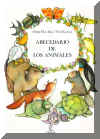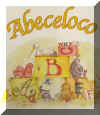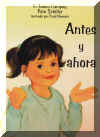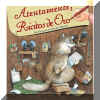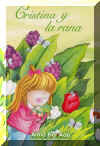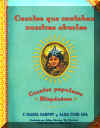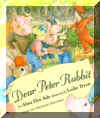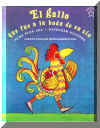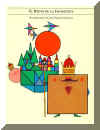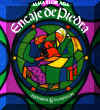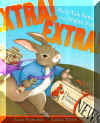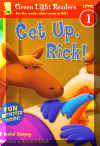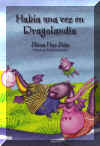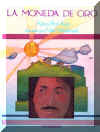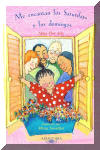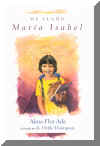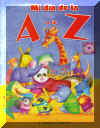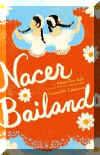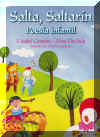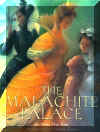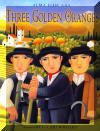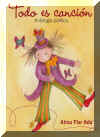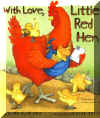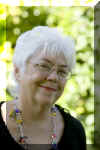 Author : Alma
Flor Ada, Illustrator : Elivia Savadier
Author : Alma
Flor Ada, Illustrator : Elivia SavadierPreschool - 2nd Grade
 Author : Alma
Flor Ada, Illustrator : Elivia Savadier
Author : Alma
Flor Ada, Illustrator : Elivia Savadier
Preschool - 2nd Grade
Me
encantan los Saturdays y los domingos
I Love Saturdays y domingos
 Me
encantan los Saturdays y los domingos, Softcover, Spanish, Book, Alma
Flor Ada, Elivia Savadier,
Preschool - 2nd Grade,
9781594375767, $12.95
Me
encantan los Saturdays y los domingos, Softcover, Spanish, Book, Alma
Flor Ada, Elivia Savadier,
Preschool - 2nd Grade,
9781594375767, $12.95
I Love
Saturdays y domingos, Softcover, English, Book, Alma
Flor Ada, Elivia Savadier,
Preschool - 2nd Grade, 9780689874093, $6.99
Watch
I Love
Saturdays y domingos, Hardcover, English, Book, Alma
Flor Ada, Elivia Savadier,
Preschool - 2nd Grade, 9780689318191, $17.99
Watch
$277.52 for the Story Collection Green Books and CDs Spanish Set, Including 20%-Off, Free Shipping, and No Sales Tax : 1 Hardcover Spanish Book, 15 Softcover Spanish Books, 2 Softcover Spanish Oversized Books, 1 Spanish Big Book, 2 Spanish Storytelling CDs, 1 Bilingual Storytelling CD, and 1 Spanish Music CD
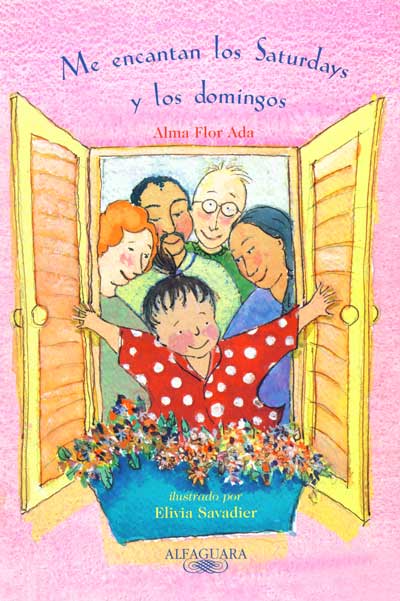 Center for Latin
American Studies, America´s Commended List
Center for Latin
American Studies, America´s Commended List
Saturdays and Sundays are very special days for the child in this story. On Saturdays, she visits Grandma and Grandpa, who come from a European-American background, and on Sundays -- los domingos -- she visits Abuelito y Abuelita, who are Mexican-American. While the two sets of grandparents are different in many ways, they also have a great deal in common -- in particular, their love for their granddaughter.
While we follow our narrator to the circus and the pier, share stories from her grandparents' pasts, and celebrate her birthday, the depth and joy of both cultures are conveyed in Spanish and English. This affirmation of both heritages will speak to all children who want to know more about their own families and ethnic backgrounds.
Author's Note : This book is very dear to me for the great reception it has received from readers. Many times during autographing sessions people tell me they want it for a special child with dual heritage, and it not only for those that share Hispanic heritage, but many others as well. While many people think I must have been inspired by my own family–two of my sons are married to women of Anglo descent and the third to a Brazilian, the idea for the book came to me, a long time ago, before any of my children had married. While in Hawaii, a Sunday afternoon in Lahaina. I watched as many families strolled by. It was apparent that they had very mixed heritage–Chinese, Japanese, Filipino, Hawaiian, Puerto Rican, Anglo– and that they felt very comfortable with each other. That experience moved me to write this story. It took a long time for the book to be published and by then I did have grandchildren with dual heritage. Some times in my own experiences I wonder whether literature reflects life or life reflects literature. Seeing this book transformed into a video has been wonderful. It made it even more interesting to be interviewed for the video in the company of my granddaughter Camille.
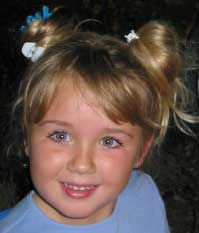 Watch
or Listen
to Vienna Rose read I Love Saturdays y domingos
to you. A marvelous example of the magical encounter between a child and
books that we wish for all children.
Watch
or Listen
to Vienna Rose read I Love Saturdays y domingos
to you. A marvelous example of the magical encounter between a child and
books that we wish for all children.
Sara
Hale : This book is an example of multicultural or international
literature. It is about a little girl who spends the weekends visiting her
grandparents. Her grandparent’s on her father’s side of the family speak
English, and her grandparents on her mother’s side of the family speak
Spanish. The book has alternating pages that go back and forth between her
experiences with each set of grandparents. When describing her Hispanic
grandparents, some of the words are written in Spanish. Even though they come
from different backgrounds, both sets of grandparents are very similar and
plan the same activities for their granddaughter, such as cooking breakfast,
playing with pets, counting things, learning about the circus, looking at
fish, etc. At the end, the girl’s whole family gets together to plan a
special birthday surprise for the little girl. The Hispanic culture is
represented by the words written in Spanish and by some of the activities
described, such as playing with piñatas and singing “Las mañanitas,” a
popular Spanish song, on her birthday.
This book would be great for any classroom to teach children about the Spanish
culture and also to show children that people from different backgrounds are
alike and enjoy similar activities! Children can also connect to the book if
they have ever spent a weekend with their grandparents. The book is especially
great for classes that have Spanish-speaking students. I read this book to a
second grade class last semester, and the whole class loved it. The
Spanish-speaking children seemed very excited to be hearing a book with some
Spanish words! They even sang the song, “Las mañanitas” for me, because I
did not know the tune. I think that 3rd-5th graders would love this book as
well, especially readers who are a bit behind grade level or students who are
still learning English. The pages basically say the same thing in English and
then again in a combination of English and Spanish, so this could help them
learn the language by seeing direct translations and connections!
Hilary Lemar : Award winning author, Alma Flor Ada, who also wrote My Name is Maria Isabel, has done an amazing job celebrating differences in culture in I Love Saturdays y domingos. This story starts off with a little girl telling about her weekends with her grandparents. She spends Saturdays with her father’s parents and domingos with her mother’s parents. She tells about what each grandmother serves her for breakfast. Her father’s mom gives her milk, scrambled eggs, and pancakes, while her mother’s mom gives her huevos rancheros. The little girl expresses her love for the differences in her grandparents’ cultures and speaks proudly of each grandparent and where they came from. This story shows how important a person’s culture is to themselves, as well as to the rest of their family. When this little girl grows up she will tell of these many different cultures that are all an important part of who she is. I think that this story is important to have in the classroom and would be great to do as a read aloud. I think that students would benefit greatly to read or have this book read to them because it will teach them that there are many different cultures and that people should be proud of their culture and who they are. I really feel like Alma Flor Ada does a wonderful job sending a positive message to be proud of and to celebrate you culture. Children will benefit from hearing this message and hopefully they will remember it in the future.
Carmen : Discussion: It is important for students to be able to compare and contrast different things. Through writing a compare/contrast paper students are able to see the similarities and differences between different things. Then it is possible for them to come to a conclusion about possibly making a decision. In the book I Love Saturdays y Domingos by Alma Flor Ada a bilingual girl compares the different activities and personal qualities that she enjoys with each of her two sets of grandparents. Though she does different activities with each set of grandparents, she loves them each the same. How to Teach It: I am going to read a book titled I Love Saturdays y Domingos by Alma Flor Ada. It is about a bilingual girl who has two sets of grandparents that are very different, but she loves them each the same. Listen for the similarities and differences that her two sets of grandparents have. In the story she calls one set of grandparents “Grandma and Grandpa” and her other set of grandparents “Abuelita and Abuelito”. Abuelita is the Spanish word for grandma and Abuelito is the Spanish word for grandpa. I’m going to have a list of the similarities and another list of the differences between the girl’s grandparents. Can anyone name any similarities between the girl’s grandparents? Ex: Both grandfathers like to tell stories about when they were growing up. Both grandmothers like to tell stories about their families when they were young. (I would write the similarities as a list on the board) Can you name any differences? Ex: Her Grandma has a cat, and her Abuelita has a dog. She watches movies about the circus with her Grandma and Grandpa. She goes to the circus with her Abuelita and Abuelito. (I would write the differences as a separate list on the board) Now that we know what a story is like that compares and contrasts different things or people, I want you to try and write your own comparing and contrasting story. You can compare/contrast anything you want. You can compare and contrast the activities and personal traits of your own grandparents like the girl in the book did, or you can pick two totally different things or people to compare and contrast. You might even try comparing two different options for a decision you are trying to make. To start off you might want to make a list of the similarities and then a list of differences so you can have a starting point for your story.
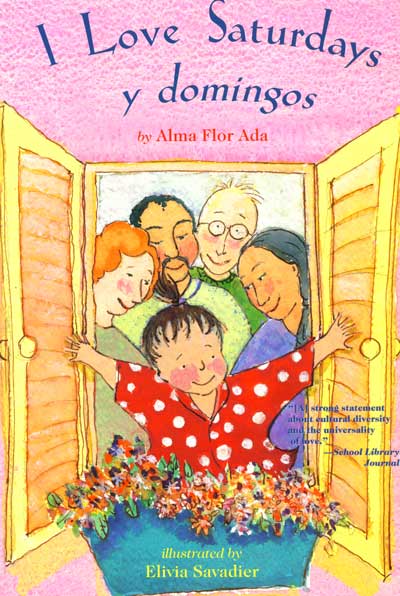 Alma Flor Ada :
Dear Carmen: I was just delighted to read your suggestions for the presentation
of my book I Love Saturdays y domingos. This book is very dear to me for the
great reception it has received from readers. Many times during autographing
sessions people tell me they want it for a special child with dual heritage, and
it not only for those that share Hispanic heritage, but many other also. Since
you like the book I'd tell you a little about its origin: While many people
think I must have been inspired by my own family --two of my sons are married to
women of Anglo descent, one to a Brazilian, the idea for the book came to me, a
long time ago, before any of my children had married. While in Hawaii, a Sunday
afternoon in Lahaina I watched many families strolled by. It was apparent that
they had very mixed heritage --Chinese, Japanese, Filipino, Hawaiian, Puerto
Rican, Anglo-- and yet they felt so comfortable among each other. It took a long
time for the book to be published and by them I did have grandchildren with dual
heritage. Again, thanks for sharing your ideas for this book and for being so
enthusiastic about the work you do. With all best wishes, cordially, Alma Flor
Ada
Alma Flor Ada :
Dear Carmen: I was just delighted to read your suggestions for the presentation
of my book I Love Saturdays y domingos. This book is very dear to me for the
great reception it has received from readers. Many times during autographing
sessions people tell me they want it for a special child with dual heritage, and
it not only for those that share Hispanic heritage, but many other also. Since
you like the book I'd tell you a little about its origin: While many people
think I must have been inspired by my own family --two of my sons are married to
women of Anglo descent, one to a Brazilian, the idea for the book came to me, a
long time ago, before any of my children had married. While in Hawaii, a Sunday
afternoon in Lahaina I watched many families strolled by. It was apparent that
they had very mixed heritage --Chinese, Japanese, Filipino, Hawaiian, Puerto
Rican, Anglo-- and yet they felt so comfortable among each other. It took a long
time for the book to be published and by them I did have grandchildren with dual
heritage. Again, thanks for sharing your ideas for this book and for being so
enthusiastic about the work you do. With all best wishes, cordially, Alma Flor
Ada
Publishers
Weekly : Through this affectionate and revealing portrait of a bilingual girl's
weekend visits to her two sets of grandparents, Ada (Where the Flame Trees
Bloom) and Savadier (A Bedtime Story) prove that straddling two worlds can be a
blessing rather than a hardship. The left of each spread depicts the narrator
spending Saturdays with her paternal grandparents, with whom she speaks English;
on the right, she passes los domingos (Sundays) with her Mexican-American
Abuelito and Abuelita and converses in Spanish. The situations in the two
households share enough similarities that readers can extrapolate the meaning of
the Spanish words in context. For instance, on one spread, the colors of the
balloons her paternal grandparents give her also appear in the kite that her
Abuelito makes for her. Each pairing makes for a loving comparison and contrast,
enlivened by Savadier's graceful, warm-toned watercolor spot illustrations. At
book's end, both sets of grandparents coordinate a cooperative gift for the
girl's birthday. The balance tips slightly in Abuelito and Abuelita's favor, in
terms of fun and exoticism (e.g., Grandpa
and Grandma watch a video about the circus while the Mexican-American
grandparents "take me to a real circus"). Youngsters, however, will
come away with the idea that this girl is very lucky to have four such
interesting people who love her. Ages 4-8.
School Library Journal : K-Gr 2-A little girl recounts the joy of her weekends,
Saturdays spent with her Euro-American Grandma and Grandpa and Sundays (los
domingos) with Abuelito and Abuelita, her Mexican-American grandparents. She
does different things in each place and goes on different outings: off to the
circus, to the pier, out floating balloons or flying kites. She hears different
stories that reflect her grandparents' heritages. However, on her birthday, it
is clear that both sets of relatives are united in their love of their
granddaughter. Lively, childlike prose that integrates Spanish words flawlessly
and understandably makes this a winner for storytimes. Savadier's watercolor
cartoon illustrations are bright, clear, and stylistically reminiscent of
Lillian Hoban's work. Paired with books like Carmen Santiago Nodar's Abuelita's
Paradise (Albert Whitman, 1992), or even such old standbys as Helen Buckley's
Grandfather and I (Lothrop, 1994), this book will make a strong statement about
cultural diversity and the universality of love.
Booklist : Ages 4-8. A little girl visits her Grandpa and Grandma, her father's
parents, on Saturdays and her "abuelito y abuelita," her mother's
parents, on "los domingos." Dearly cherished by both sets of
grandparents, the little girl delights in the unique differences of the two
households and moves with ease between the two cultures. Although the little
girl uses Spanish words and phrases in describing her Sundays with her Mexican
American grandparents, for the most part the meanings are explained or can be
inferred from the context. Showing the various weekend experiences, Savadier's
softly colored watercolor illustrations reflect the happy heart of the little
girl. Together, Ada and Savadier have created a picture book that gracefully
embraces and celebrates a young child's involvement in her dual heritages.
Especially recommended for libraries serving Latino and multicultural
communities.
Mrs Lawrence : In one of her most popular works, Ada tells of a young girl enjoying the similarities and the differences between her English-speaking and Spanish-speaking grandparents. On Saturdays she goes to visit her father’s parents, Grandma and Grandpa. On Sundays she spends the day with her mother’s parents, Abuelito y Abuelita. She eats different breakfasts with each grandparent. Grandma has a cat named Taffy. Abuelita has a dog named Canelo. The young girl spends her weekend doing various activities with both sets of grandparents. It’s time to celebrate her birthday. She gets a new doll from Grandma and Grandpa and a dress. Her Abuelito has made her a dollhouse and Abuelita has made her a dress. The dress is the same as her doll. The kids take turn breaking the piñata. Her family celebrates by singing Happy Birthday and Las Mananitas. This multicultural story is warm and soft just like Elivia Savadier’s watercolor illustrations. Other titles by Ada are Dear Peter Rabbit, With Love, Little Red Hen, Three Golden Oranges, Yours Truly Goldilocks, and The Golden Coin. She received the Pura Belpre medal for her book Under the Royal Palms: A Childhood in Cuba. I thought this book was an excellent choice to teaching multicultural education. It really does include the beauty of diversity and the warm feeling of togetherness. This book is definitely a thumbs up, especially in the diversity category. An excellent way to help others understand the uniqueness of multicultural families.
Mrs Moore : I Love Saturdays y domingos by Alma Flor Ada: Award winning Alma Flor Ada (With Love, Little Red Hen) demonstrates the differences between two cultures in this book and how no matter what the differences, love is universal. A young girl encounters different experiences with two sets of grandparents during her weekend visits with them. One set of grandparents is English speaking while the other set speaks Spanish. The girl takes pleasure in how her grandparents are different in many ways, yet they have many things in common. One grandfather tells the girl stories about coming from Europe while abuelito tells stories about Mexico. Another difference is that the English-speaking grandparents make the girl pancakes for breakfast while the Spanish-speaking grandparents make juevos rancheros. The illustrations portray the joy and the love that family members share with each other. Elivia Savadier’s bright watercolor illustrations wonderfully capture the main thing that both sets of grandparents share in common in this story, which is their love for their granddaughter. This is a fabulous book that can be used to demonstrate the variety of cultures.. It could also be used to show that although there may be differences between cultures, people can all come together in love. I truly enjoyed this book especially because I can relate to it. My children have one set of grandparents that are English speaking and a set who speak English and Spanish. The two sets of grandparents share several differences and similarities. But one thing that they definitely share in common is that both sets love my children. As my son says, “I love Nana, Tata, Gigi and Papa and they love me.” Mrs Moore : Target Audience: 2nd Grade, Discussion: This book is a great book to use to demonstrate the differences between cultures and heritages. It can be used to teach about the many ways birthdays can be celebrated among different cultures. In a class with much diversity, children will get to know more about their classmates. Children will get a better understanding about other cultures and gain knowledge of the difference in celebrations among various people. How to Teach It: Today I will be reading the book I love Saturday y domingos. Okay class, now that we have read this book, what were some of the differences between the two cultures in the book? In what ways were both sets of grandparents different? Did they share anything in common? What did you think about how they celebrated the girl’s birthday? How does your family celebrate birthdays? Do you know of birthday traditions from other cultures? Now we will be writing about your own family birthday traditions and compare it to a birthday tradition of another culture. (Allow students some time to research other cultures in the school library as well as in the computer lab.) Now that we have written our papers, who would like to share what they have written first?
Story
Collection Green Books and CDs
:
